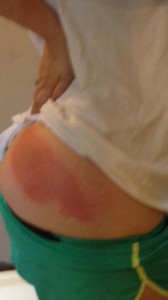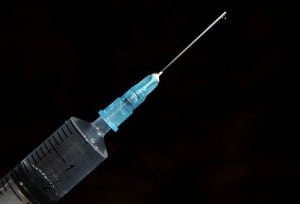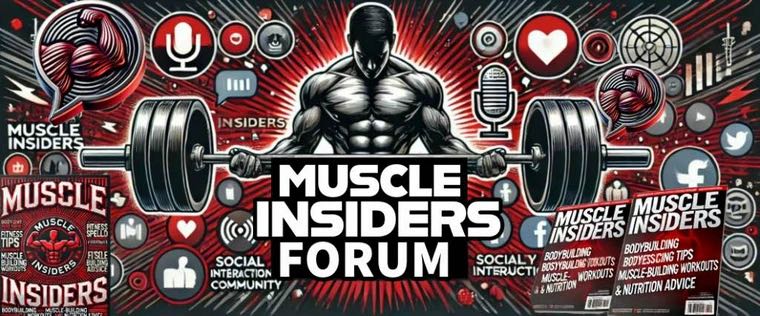by Ed Barillas,
It is very common for someone to experience pain after injecting either underground lab or pharmaceutical grade drugs and it always leaves people wondering what the causes are. I will try to explain the 3 major causes of this pain and give advice on how to avoid it.
 The glutes are mostly free of lymph nodes but if one is hit it can be very painful.
The glutes are mostly free of lymph nodes but if one is hit it can be very painful.
The first cause of post injection pain is when you hit the lymphatic system with your needle. Even though it is still very rare, it should still nonetheless be mentioned. The lymphatic system is as intensive as the circulatory system, but the problem is that the standard injection sights such as the medial delts, Glute, vastus lateralis and ventro-glute, are basically void of lymphatic nodes and if a lymph node is hit with an injection, the pain is surely to be severe, the edema vast and the swelling will come on both very fast and severe. The pain is also likely to pass along the lymph system to the next lymph gland. This happens more often with a vastus lateralis shot where the swelling tracks down toward the back of the knee. And unlike the edema experienced with tissue irritation, which happens only with the muscle, the edema with a lymphatic puncture will be both inter and intra-muscular with a moderate amount of swelling just underneath the skin, which will give it a softer puffy feel and can simply be tested by pressing the swollen area with your finger. If an indentation does remain, you have a more systematic edema and more than just local tissue irritations. The other most obvious difference is that the swelling should neither be warm or hot to the touch.
It is recommended to use ice and ibuprofen to help with this. Also note that the affected area must be rested as the patient can expect pain and swelling to start to disperse after 72 hours and last at least 10 days. Be mindful that painful areas must not be massaged.
The second cause of post injection pain is tissue irritation. This is perhaps the most likely cause of post injection pain and the least serious. Tissue irritation is likely to start 12-24 hours after injection and pain can be mild to moderate depending on the level of tissue irritation and the amount injected. The injection site is likely to swell within the muscle, perhaps red and likely to be warm and very firm to the touch. The swelling and pain will start to subside after 72 hours and can last over a week in the most severe cases. Its important to note that the most likely causes of tissue irritation are when the steroid hormone crashes out of the solution in the depot as this causes crystallization of the steroid hormone and this in turn places a lot of pressure on the nerve endings in the muscle belly which causes pain, knotting and swelling. This is most common in long chain esters, high mg/ml concentration anabolic steroids and steroids compounded with less than an ideal oil blend. Another cause can be a reaction to the acid compounds within the ester. This happens when the metabolic breakdown of the ester attached to the hormone free form acids, which are released, which in step cause the muscle tissue to become rapidly irritated at the injection site. This is most common with propionic acid of the propionate ester as well as poor quality raw materials also liberate more freeform acids.
Another cause can be excessive preservative or when too much benzyl alcohol is used to formulate the solution inflammation and as a result pain may result. Pharmaceutical grade usually contains 0.9% benzyl alcohol. Common underground lab products contain on average 2%. Also keep in mind that anything above 1.2% offers no added anti-microbial effects. Due to water soluble nature of benzyl alcohol, tissue irritation of this nature has been known to travel as the excessive alcohol disperses via the blood stream. This is most common with injection into the quads, or the vastus lateralis as the pain travels down toward the knee. Ice and ibuprofen may help with the swelling as well as hot baths, showers and massage of the injection site as this may help to distribute the injection and reduce pain.
 Inflammation due to irritation is the most common cause of post injection pain.
Inflammation due to irritation is the most common cause of post injection pain.
The third cause of post injection pain is an infection and abscess in the injection site, which can be the most serious causes of injection pain. An infection will start in the same manner as tissue irritation with local pain and swelling, with heat and redness around the muscle. The major difference is that after 72 hours tissue irritation should start to lessen and if the area is indeed infected this pain and swelling will get worse. The swelling will change in nature becoming more systematic and edema will start to form under the skin and become softer and spongier.
Please note that there are many reasons why an infection can manifest (like poor injection technique) so you must make sure the injection site and rubber stopper is clean and swabbed with an alcohol wipe.
 Make sure your gear is properly sanitized to avoid infections at your injection sites.
Make sure your gear is properly sanitized to avoid infections at your injection sites.
Also, the moisture from the alcohol swab should be allowed to dry before preparing to inject. It is extremely rare but if the alcohol is not allowed to dry, the bacterium has not been allowed sufficient time to be killed off. If this partly destroyed bacterium was then pushed into a muscle through an inter-muscular injection the bacterium can evolve into a superbug. Always be sure to use a clean and new syringe barrel and pin and not allow the pin to touch anything before you inject. Also avoid pinning through a hair follicle or hair and try not to inject too quickly as injecting too quickly can increase the risk of infection as this in turn increases injection trauma.
Another cause of infection is not rotating injection sites. The risk of infection is massively increased if the same injection site is used over and over again without giving it time to recover. The more an injury is irritated the more likely it is to become infected.
The last cause of infection can be contaminated drugs. In my opinion this is probably the least common cause of infection with oil-based injections so be sure to use reputable underground labs or pharmaceutical sources and avoid water-based suspensions.
It is very common for someone to experience pain after injecting either underground lab or pharmaceutical grade drugs and it always leaves people wondering what the causes are. I will try to explain the 3 major causes of this pain and give advice on how to avoid it.
 The glutes are mostly free of lymph nodes but if one is hit it can be very painful.
The glutes are mostly free of lymph nodes but if one is hit it can be very painful.The first cause of post injection pain is when you hit the lymphatic system with your needle. Even though it is still very rare, it should still nonetheless be mentioned. The lymphatic system is as intensive as the circulatory system, but the problem is that the standard injection sights such as the medial delts, Glute, vastus lateralis and ventro-glute, are basically void of lymphatic nodes and if a lymph node is hit with an injection, the pain is surely to be severe, the edema vast and the swelling will come on both very fast and severe. The pain is also likely to pass along the lymph system to the next lymph gland. This happens more often with a vastus lateralis shot where the swelling tracks down toward the back of the knee. And unlike the edema experienced with tissue irritation, which happens only with the muscle, the edema with a lymphatic puncture will be both inter and intra-muscular with a moderate amount of swelling just underneath the skin, which will give it a softer puffy feel and can simply be tested by pressing the swollen area with your finger. If an indentation does remain, you have a more systematic edema and more than just local tissue irritations. The other most obvious difference is that the swelling should neither be warm or hot to the touch.
It is recommended to use ice and ibuprofen to help with this. Also note that the affected area must be rested as the patient can expect pain and swelling to start to disperse after 72 hours and last at least 10 days. Be mindful that painful areas must not be massaged.

The second cause of post injection pain is tissue irritation. This is perhaps the most likely cause of post injection pain and the least serious. Tissue irritation is likely to start 12-24 hours after injection and pain can be mild to moderate depending on the level of tissue irritation and the amount injected. The injection site is likely to swell within the muscle, perhaps red and likely to be warm and very firm to the touch. The swelling and pain will start to subside after 72 hours and can last over a week in the most severe cases. Its important to note that the most likely causes of tissue irritation are when the steroid hormone crashes out of the solution in the depot as this causes crystallization of the steroid hormone and this in turn places a lot of pressure on the nerve endings in the muscle belly which causes pain, knotting and swelling. This is most common in long chain esters, high mg/ml concentration anabolic steroids and steroids compounded with less than an ideal oil blend. Another cause can be a reaction to the acid compounds within the ester. This happens when the metabolic breakdown of the ester attached to the hormone free form acids, which are released, which in step cause the muscle tissue to become rapidly irritated at the injection site. This is most common with propionic acid of the propionate ester as well as poor quality raw materials also liberate more freeform acids.
Another cause can be excessive preservative or when too much benzyl alcohol is used to formulate the solution inflammation and as a result pain may result. Pharmaceutical grade usually contains 0.9% benzyl alcohol. Common underground lab products contain on average 2%. Also keep in mind that anything above 1.2% offers no added anti-microbial effects. Due to water soluble nature of benzyl alcohol, tissue irritation of this nature has been known to travel as the excessive alcohol disperses via the blood stream. This is most common with injection into the quads, or the vastus lateralis as the pain travels down toward the knee. Ice and ibuprofen may help with the swelling as well as hot baths, showers and massage of the injection site as this may help to distribute the injection and reduce pain.
 Inflammation due to irritation is the most common cause of post injection pain.
Inflammation due to irritation is the most common cause of post injection pain.The third cause of post injection pain is an infection and abscess in the injection site, which can be the most serious causes of injection pain. An infection will start in the same manner as tissue irritation with local pain and swelling, with heat and redness around the muscle. The major difference is that after 72 hours tissue irritation should start to lessen and if the area is indeed infected this pain and swelling will get worse. The swelling will change in nature becoming more systematic and edema will start to form under the skin and become softer and spongier.
Please note that there are many reasons why an infection can manifest (like poor injection technique) so you must make sure the injection site and rubber stopper is clean and swabbed with an alcohol wipe.
 Make sure your gear is properly sanitized to avoid infections at your injection sites.
Make sure your gear is properly sanitized to avoid infections at your injection sites.Also, the moisture from the alcohol swab should be allowed to dry before preparing to inject. It is extremely rare but if the alcohol is not allowed to dry, the bacterium has not been allowed sufficient time to be killed off. If this partly destroyed bacterium was then pushed into a muscle through an inter-muscular injection the bacterium can evolve into a superbug. Always be sure to use a clean and new syringe barrel and pin and not allow the pin to touch anything before you inject. Also avoid pinning through a hair follicle or hair and try not to inject too quickly as injecting too quickly can increase the risk of infection as this in turn increases injection trauma.
Another cause of infection is not rotating injection sites. The risk of infection is massively increased if the same injection site is used over and over again without giving it time to recover. The more an injury is irritated the more likely it is to become infected.
The last cause of infection can be contaminated drugs. In my opinion this is probably the least common cause of infection with oil-based injections so be sure to use reputable underground labs or pharmaceutical sources and avoid water-based suspensions.

Comment